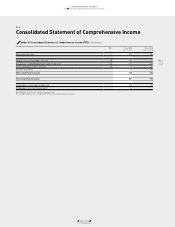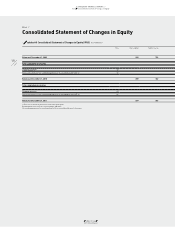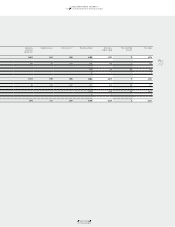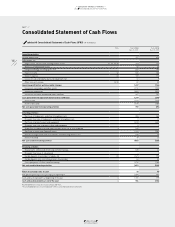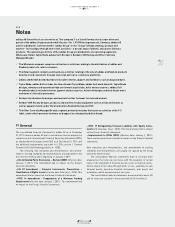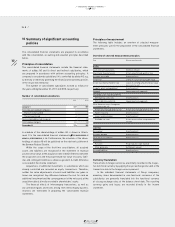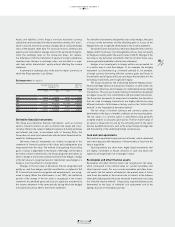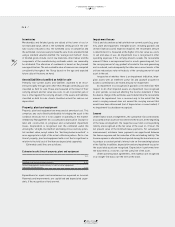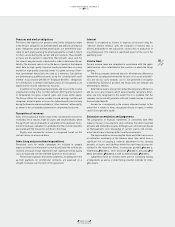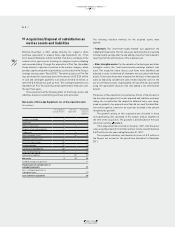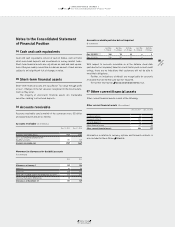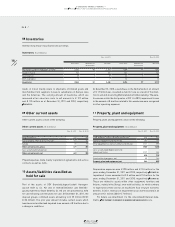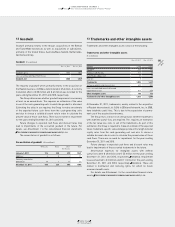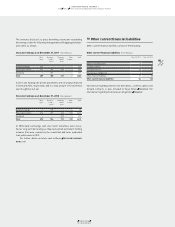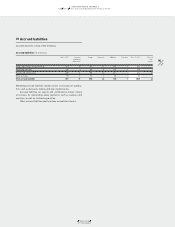Reebok 2011 Annual Report Download - page 191
Download and view the complete annual report
Please find page 191 of the 2011 Reebok annual report below. You can navigate through the pages in the report by either clicking on the pages listed below, or by using the keyword search tool below to find specific information within the annual report.
adidas Group
2011 Annual Report
CONSOLIDATED FINANCIAL STATEMENTS
04.8 Notes
187
2011
187
2011
Pensions and similar obligations
Provisions and expenses for pensions and similar obligations relate
to the Group’s obligations for defined benefit and defined contribution
plans. Obligations under defined benefit plans are determined sepa-
rately for each plan by valuing the employee benefits accrued in return
for their service during the current and prior periods. These benefit
accruals are discounted to determine their present value, and the
fair value of any plan assets is deducted in order to determine the net
liability. The discount rate is set on the basis of yields at the balance
sheet date for high-quality corporate bonds provided there is a deep
market for high-quality corporate bonds in a given currency. Other-
wise, government bond yields are used as a reference. Calculations
are performed by qualified actuaries using the “projected unit credit
method” in accordance with IAS 19 “Employee Benefits”. Obligations
for contributions to defined contribution plans are recognised as an
expense in the income statement as incurred.
In addition to recognising actuarial gains and losses in the income
statement according to the “corridor method”, IAS 19 grants the option
to immediately recognise actuarial gains and losses within equity.
The Group utilises this option in order to avoid earnings volatility and
recognises actuarial gains or losses for defined benefit plans arising
during the financial year immediately in “other reserves” within equity,
as shown in the consolidated statement of comprehensive income.
Recognition of revenues
Sales are recognised at the fair value of the consideration received or
receivable, net of returns, trade discounts and volume rebates, when
the significant risks and rewards of ownership of the goods are trans-
ferred to the buyer, and when it is probable that the economic benefits
associated with the transaction will flow to the Group.
Royalty and commission income is recognised based on the
contract terms on an accrual basis.
Advertising and promotional expenditures
Production costs for media campaigns are included in prepaid
expenses (other current and non-current assets) until the services are
received, and upon receipt expensed in full. Significant media buying
costs are expensed over the intended duration of the broadcast.
Promotional expenses that involve payments, including one-time
up-front payments for promotional contracts, are expensed on a
straight-line basis over the term of the agreement.
Interest
Interest is recognised as income or expense as incurred using the
“effective interest method” with the exception of interest that is
directly attributable to the acquisition, construction or production of
a qualifying asset. This interest is capitalised as part of the cost of the
qualifying asset.
Income taxes
Current income taxes are computed in accordance with the appli-
cable taxation rules established in the countries in which the Group
operates.
The Group computes deferred taxes for all temporary differences
between the carrying amount and the tax base of its assets and liabil-
ities and tax loss carry-forwards. As it is not permitted to recognise
a deferred tax liability for goodwill, the Group does not compute any
deferred taxes thereon.
Deferred tax assets arising from deductible temporary differences
and tax loss carry-forwards which exceed taxable temporary differ-
ences are only recognised to the extent that it is probable that the
company concerned will generate sufficient taxable income to realise
the associated benefit.
Income tax is recognised in the income statement except to the
extent that it relates to items recognised directly in equity, in which
case it is recognised in equity.
Estimation uncertainties and judgements
The preparation of financial statements in conformity with IFRS
requires the use of assumptions and estimates that affect reported
amounts and related disclosures. Although such estimates are based
on Management’s best knowledge of current events and actions,
actual results may ultimately differ from these estimates.
The key assumptions concerning the future and other key sources
of estimation uncertainty at the balance sheet date which have a
signifi cant risk of causing a material adjustment to the carrying
amounts of assets and liabilities within the next financial year are
outlined in the respective Notes, in particular goodwill
SEE NOTE 12
,
trademarks
SEE NOTE 13
, other provisions
SEE NOTE 19
, pensions
SEE
NOTE 23
, derivatives
SEE NOTE 28
as well as deferred taxes
SEE NOTE 33
.
Judgements have for instance been used in classifying leasing
arrangements as well as in determining valuation methods for intan-
gible assets.


